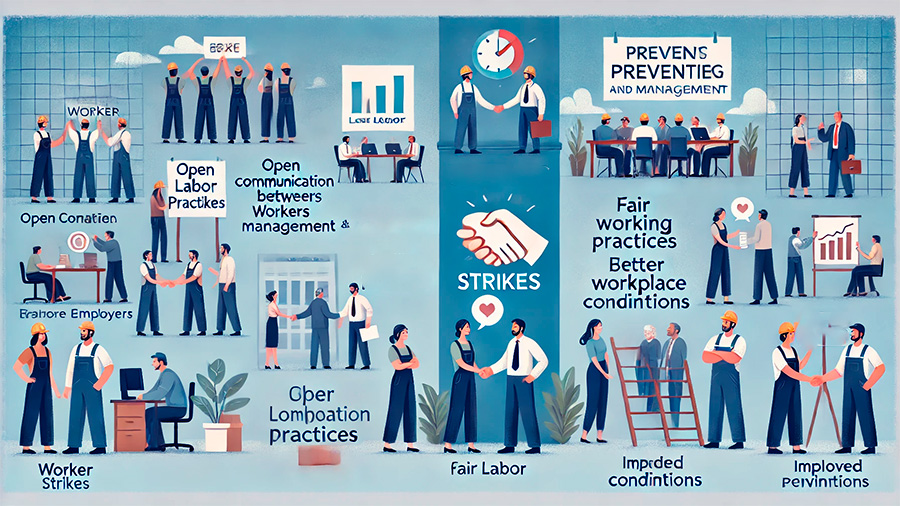Uncovering the Root Causes of Worker Strikes and Effective Prevention Methods

Worker strikes can have far-reaching consequences for businesses, industries, and economies, leading to disrupted operations, lost productivity, and financial losses. Strikes often arise when employees feel their needs, rights, or concerns are not being adequately addressed by management or governing bodies. By understanding the root causes of strikes and implementing proactive measures, companies and organizations can work to prevent them and maintain stable, productive work environments.
This article explores the common causes of worker strikes and outlines effective methods for preventing them, ensuring a harmonious relationship between employees and employers.
Root Causes of Worker Strikes
Strikes occur when workers collectively decide to stop working as a form of protest against perceived unfair labor practices, inadequate compensation, poor working conditions, or other grievances. While the specific causes of strikes can vary by industry or region, there are several key factors that frequently lead to labor unrest. Understanding these underlying issues is crucial for preventing strikes and maintaining positive employer-employee relationships.
1. Wage Disputes
One of the most common causes of worker strikes is dissatisfaction with wages. When employees feel that their compensation does not reflect the work they perform, or when wages fail to keep pace with the cost of living, tensions can rise. Wage disputes can also occur if there are significant disparities between what workers earn and what management or executives are compensated, leading to feelings of unfairness.
How wage disputes lead to strikes:
- Inadequate compensation: Employees may strike if they believe their wages are insufficient compared to the work they perform.
- Pay inequity: Disparities between worker and executive pay can create resentment, fueling demands for higher wages or better benefits.
2. Poor Working Conditions
Unsafe or unhealthy working conditions are another major cause of worker strikes. Employees are more likely to strike if they feel that their health or safety is at risk due to inadequate equipment, insufficient training, or hazardous work environments. Strikes related to working conditions often arise when employers fail to comply with safety regulations or ignore employee concerns about workplace safety.
Examples of poor working conditions:
- Lack of safety equipment: Employees may protest if they are not provided with the necessary protective gear for dangerous tasks.
- Hazardous environments: Exposure to toxic substances or unsafe machinery can lead to strikes if employees feel their health is at risk.
3. Unfair Labor Practices
Strikes can also be triggered by perceived unfair labor practices, such as discriminatory treatment, inconsistent enforcement of policies, or the violation of workers’ rights. If employees feel that management is treating them unfairly, failing to recognize their contributions, or violating labor laws, they may resort to striking as a way to demand changes. Unions often organize strikes in response to unfair labor practices to push for better representation and collective bargaining rights.
Types of unfair labor practices:
- Discrimination: Strikes may occur if workers face discrimination based on gender, race, or other factors, leading to unequal treatment or pay.
- Violation of rights: Employees may strike if they believe their rights, such as the right to organize or receive fair compensation, are being violated.
4. Lack of Benefits and Job Security
Workers are more likely to strike if they lack access to adequate benefits, such as health insurance, retirement plans, or paid leave. Insecure job conditions, such as temporary contracts or frequent layoffs, can also create an environment of uncertainty that drives workers to demand better terms. Job security and benefits are essential to workers’ overall well-being, and strikes can occur when these needs are not met.
How lack of benefits leads to strikes:
- Inadequate health insurance: Workers may strike if their employer fails to provide sufficient healthcare coverage or other essential benefits.
- Unstable employment: Fear of layoffs or the inability to secure long-term contracts can lead to strikes, as employees push for greater job security.

Methods for Preventing Worker Strikes
Preventing worker strikes requires proactive measures that address the root causes of labor unrest and foster a positive, communicative relationship between management and employees. By implementing fair labor practices, improving working conditions, and engaging in open dialogue with workers, employers can significantly reduce the risk of strikes and maintain a productive workforce.
1. Fair Compensation and Benefits
Ensuring that employees receive fair wages and benefits is one of the most effective ways to prevent worker strikes. Employers should regularly review compensation packages to ensure they are competitive with industry standards and reflect the cost of living. Additionally, offering benefits such as health insurance, retirement plans, and paid leave can help improve job satisfaction and reduce the likelihood of labor disputes.
Strategies for providing fair compensation:
- Conduct wage audits: Regularly assess wage structures to ensure employees are paid fairly for their work and that there are no significant pay disparities.
- Offer comprehensive benefits: Provide employees with access to healthcare, retirement plans, and paid time off to support their overall well-being.
2. Ensuring Safe and Healthy Working Conditions
Creating a safe and healthy work environment is essential for preventing strikes related to poor working conditions. Employers should ensure that all safety regulations are met, provide adequate training for workers, and address any safety concerns raised by employees. Regular safety inspections, hazard assessments, and open communication channels for reporting issues can help mitigate risks and prevent labor unrest.
Steps to improve workplace safety:
- Provide safety equipment: Ensure that employees have access to the necessary protective gear and safety equipment for their roles.
- Conduct regular safety training: Offer ongoing training to educate workers on safety protocols, emergency procedures, and best practices.

3. Open Communication and Employee Engagement
Open communication between management and employees is critical for preventing misunderstandings and resolving potential disputes before they escalate into strikes. Employers should create opportunities for workers to voice their concerns, offer feedback, and participate in decision-making processes that affect their jobs. Regular meetings, surveys, and employee forums can help foster transparency and build trust between employers and employees.
How to encourage open communication:
- Hold regular meetings: Schedule routine meetings between management and employees to discuss workplace issues and potential improvements.
- Provide feedback channels: Offer anonymous channels for employees to submit concerns or suggestions without fear of retaliation.
4. Addressing Unfair Labor Practices
Employers must be diligent in ensuring that all labor practices comply with local, state, and federal labor laws. Discriminatory treatment, violation of workers’ rights, or inconsistent enforcement of policies can quickly lead to dissatisfaction and strikes. To prevent this, employers should regularly review their labor policies, ensure that they are applied consistently, and provide training on legal and ethical labor practices.
Preventing unfair labor practices:
- Conduct regular policy reviews: Ensure that workplace policies are up-to-date, fair, and comply with all applicable labor laws.
- Provide management training: Offer training to supervisors and managers on how to apply labor policies fairly and treat all employees with respect.
5. Negotiating with Unions and Workers
In industries where unions represent workers, negotiating collective bargaining agreements (CBAs) is a crucial step in preventing strikes. These agreements establish clear terms for wages, benefits, working conditions, and dispute resolution. By negotiating fairly and in good faith with unions, employers can create agreements that satisfy both parties and reduce the likelihood of labor disputes.
Effective union negotiation strategies:
- Engage in good faith bargaining: Approach negotiations with a genuine intent to reach mutually beneficial agreements that meet the needs of both the employer and employees.
- Address grievances promptly: When union representatives raise concerns, work to resolve issues quickly and fairly to prevent escalation into strikes.
Conclusion
Worker strikes are often the result of unresolved grievances related to wages, working conditions, unfair labor practices, or job insecurity. By understanding the root causes of these strikes and implementing proactive strategies to address employee concerns, employers can reduce the risk of labor unrest and maintain a stable, productive workforce. Fair compensation, safe working conditions, open communication, and strong relationships with unions are all critical components of a successful strategy for preventing worker strikes.


